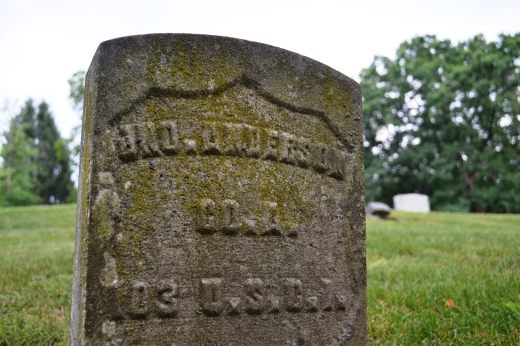John Anderson was born into slavery in Missouri around 1833, though he would claim Virginia for many years, and in 1863 wrote ‘Dixie’ as place of birth on his draft registration. Escaping bondage, he arrived in Washtenaw County by at least 1860 when he is found working on the Rowe family farm outside of Manchester.
John joined Company A of the 102nd United States Colored Troops in February, 1865 and mustered out in Charleston, South Carolina of September that year. Returning to Michigan after the war, he married Lucy York in 1867. John was an early member, and one of the few Colored Troops veterans, in the local post of the Grand Army of the Republic. John is one of only three adults on South Adams Street listed as illiterate in 1900. He worked as a day laborer and drayman.
Lucy York was the daughter of Washington and Sarah York, both born in Kentucky who came north in the 1840s, possibly for a time to Canada. Lucy was probably born in Kentucky and in bondage. The Yorks were among the earliest black residents of Ypsilanti, arriving in the early 1850s. They were founding members of Brown AME Church in 1854.
Her brothers George and David both joined the Co. B of the 102nd USCT from Ypsilanti in October of 1863, meaning as soon as it was possible for them to. David was just 18 and George even a couple of years younger. George died of disease before mustering out in 1864. David survived the war and lived across the street from Lucy for many years. By 1900, Lucy would have been considered an ‘old settler’ of the village with roots in Ypsilanti as deep as any white member of the community.
Both were active in the community Second AME. Lucy was a member of the Good Samaritans. Together John and Lucy had five children. Living with them were their son Fred, 21, a waiter and his wife Alice, 21. A daughter, Florence, 9, was living with them as was their widowed daughter-in-law Victoria, 27, and two grandchildren, Benicia, an infant, and Floyd, 7. Lucy died in 1912 and John in 1907. He is buried in Highland Cemetery with a Grand Army of the Republic headstone.
A January, 1902 article in the Ypsilanti-Sentinel gives what is, perhaps, the only first-hand account of an escape from bondage by a resident of Adams Street. While there is no reason to doubt Anderson’s story, it must be remembered that it was related to a white,-owned and usually hostile, newspaper.
An obituary from the December 7, 1907 Ypsilanti Press reads:
Was a Soldier and a Slave
John Anderson, who had lived nearly a century, died this morning,
When he escaped from servitude a large reward was offered for his capture.
John Anderson, one of the residents of this city died this morning at his home on Adams Street of old age.
He had been a slave and soldier in the late Civil War. But a short while ago he visited the county in Missouri where he had escaped from servitude and there he met one of his old masters who recognized him and conversed on the large reward offered for his capture. He left a wife, Mrs. Lucy Anderson, two sons, Fred and Alfred Anderson, survive him.
He had a host of friends and is held in high esteem by all who knew him. He was one of Ypsilanti’s oldest and best known colored citizens.
While his exact age is not known, it is thought he must be nearly 100 years old.
*John was around 75 when he died.





